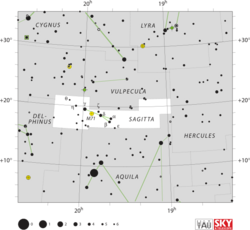Astronomy:Zeta Sagittae
| Observation data Equinox J2000.0]] (ICRS) | |
|---|---|
| Constellation | Sagitta |
| Right ascension | 19h 48m 58.65978s[1] |
| Declination | +19° 08′ 31.3516″[1] |
| Apparent magnitude (V) | +5.00[2] (5.64 + 6.04 + 9.01)[3] |
| Characteristics | |
| Spectral type | A3 Vnn[4] (A1 V + A3 V)[5] |
| U−B color index | +0.06[2] |
| B−V color index | +0.10[2] |
| Astrometry | |
| Proper motion (μ) | RA: +17.63[1] mas/yr Dec.: +26.27[1] mas/yr |
| Parallax (π) | 12.79 ± 0.67[1] mas |
| Distance | 260 ± 10 ly (78 ± 4 pc) |
| Absolute magnitude (MV) | +0.55[6] |
| Orbit[7] | |
| Period (P) | 8487.9±4.9 d |
| Semi-major axis (a) | 0.13605±0.00044″ |
| Eccentricity (e) | 0.7948±0.0019 |
| Inclination (i) | 132.33±0.41° |
| Longitude of the node (Ω) | 340.97±0.68° |
| Periastron epoch (T) | 44199.6±5.9 HMJD |
| Argument of periastron (ω) (secondary) | 355.3±1.0° |
| Details | |
| ζ Sge A | |
| Mass | 1.80[8] M☉ |
| Radius | 1.7[9] R☉ |
| Luminosity | 46[10] L☉ |
| Surface gravity (log g) | 3.89[8] cgs |
| Temperature | 8,422±286[8] K |
| Rotational velocity (v sin i) | 240[11] km/s |
| Age | 347[8] Myr |
| Other designations | |
| Database references | |
| SIMBAD | data |
Zeta Sagittae (ζ Sagittae) is triple star[3] system in the northern constellation of Sagitta. It is visible to the naked eye, having a combined apparent visual magnitude of +5.00.[2] Based upon an annual parallax shift of 12.79 mas,[1] the distance to this star is approximately 260 light years.
The inner pair is a visual binary system consisting of two A-type main-sequence stars with an orbital period of 23.2 years (8,487.9 d), a semimajor axis of 0.136 arc seconds, and an eccentricity of 0.79.[7] The primary, component A, has a visual magnitude of 5.64[3] with a stellar classification of A3 Vnn,[4] where the 'nn' suffix indicates "nebulous" lines due to rotation. It is spinning rapidly with a projected rotational velocity of 240 km/s. This is giving the star an oblate shape with an equatorial bulge that is 14% larger than the polar radius.[11]
The secondary member, component B, is a magnitude 6.04 star, while the more distant component C is magnitude 9.01 and lies at an angular separation of 8.330 arc seconds from the other two.[3]
Naming
In Chinese, 左旗 (Zuǒ Qí), meaning Left Flag, refers to an asterism consisting of ζ Sagittae, α Sagittae, β Sagittae, δ Sagittae, γ Sagittae, 13 Sagittae, 11 Sagittae, 14 Sagittae and ρ Aquilae. Consequently, the Chinese name for ζ Sagittae itself is 左旗四 (Zuǒ Qí sì, English: the Fourth Star of Left Flag.)[13]
References
- ↑ Jump up to: 1.0 1.1 1.2 1.3 1.4 1.5 van Leeuwen, F. (2007), "Validation of the new Hipparcos reduction", Astronomy and Astrophysics 474 (2): 653–664, doi:10.1051/0004-6361:20078357, Bibcode: 2007A&A...474..653V.
- ↑ Jump up to: 2.0 2.1 2.2 2.3 Johnson, H. L. et al. (1966), "UBVRIJKL photometry of the bright stars", Communications of the Lunar and Planetary Laboratory 4 (99): 99, Bibcode: 1966CoLPL...4...99J.
- ↑ Jump up to: 3.0 3.1 3.2 3.3 Eggleton, P. P.; Tokovinin, A. A. (September 2008), "A catalogue of multiplicity among bright stellar systems", Monthly Notices of the Royal Astronomical Society 389 (2): 869–879, doi:10.1111/j.1365-2966.2008.13596.x, Bibcode: 2008MNRAS.389..869E.
- ↑ Jump up to: 4.0 4.1 Cowley, A. et al. (April 1969), "A study of the bright A stars. I. A catalogue of spectral classifications", Astronomical Journal 74: 375–406, doi:10.1086/110819, Bibcode: 1969AJ.....74..375C.
- ↑ Christy, James W.; Walker, R. L., Jr. (October 1969), "MK Classification of 142 Visual Binaries", Publications of the Astronomical Society of the Pacific 81 (482): 643, doi:10.1086/128831, Bibcode: 1969PASP...81..643C.
- ↑ Anderson, E.; Francis, Ch. (2012), "XHIP: An extended hipparcos compilation", Astronomy Letters 38 (5): 331, doi:10.1134/S1063773712050015, Bibcode: 2012AstL...38..331A.
- ↑ Jump up to: 7.0 7.1 Muterspaugh, Matthew W. et al. (December 2010), "The Phases Differential Astrometry Data Archive. II. Updated Binary Star Orbits and a Long Period Eclipsing Binary", The Astronomical Journal 140 (6): 1623–1630, doi:10.1088/0004-6256/140/6/1623, Bibcode: 2010AJ....140.1623M.
- ↑ Jump up to: 8.0 8.1 8.2 8.3 David, Trevor J.; Hillenbrand, Lynne A. (2015), "The Ages of Early-Type Stars: Strömgren Photometric Methods Calibrated, Validated, Tested, and Applied to Hosts and Prospective Hosts of Directly Imaged Exoplanets", The Astrophysical Journal 804 (2): 146, doi:10.1088/0004-637X/804/2/146, Bibcode: 2015ApJ...804..146D.
- ↑ Pasinetti Fracassini, L. E. et al. (February 2001), "Catalogue of Apparent Diameters and Absolute Radii of Stars (CADARS)", Astronomy and Astrophysics 367: 521–524, doi:10.1051/0004-6361:20000451, Bibcode: 2001A&A...367..521P.
- ↑ McDonald, I. et al. (2012), "Fundamental Parameters and Infrared Excesses of Hipparcos Stars", Monthly Notices of the Royal Astronomical Society 427 (1): 343–57, doi:10.1111/j.1365-2966.2012.21873.x, Bibcode: 2012MNRAS.427..343M.
- ↑ Jump up to: 11.0 11.1 Belle, G. T. (2012), "Interferometric observations of rapidly rotating stars", The Astronomy and Astrophysics Review 20 (1): 51, doi:10.1007/s00159-012-0051-2, Bibcode: 2012A&ARv..20...51V.
- ↑ "zet Sge". SIMBAD. Centre de données astronomiques de Strasbourg. http://simbad.u-strasbg.fr/simbad/sim-basic?Ident=zet+Sge.
- ↑ (in Chinese) AEEA (Activities of Exhibition and Education in Astronomy) 天文教育資訊網 2006 年 7 月 3 日
External links
- Kaler, James B. (August 3, 2012), "Zeta Sagittae", stars (University of Illinois), http://stars.astro.illinois.edu/sow/zetasge.html, retrieved 2017-07-13.
 |


